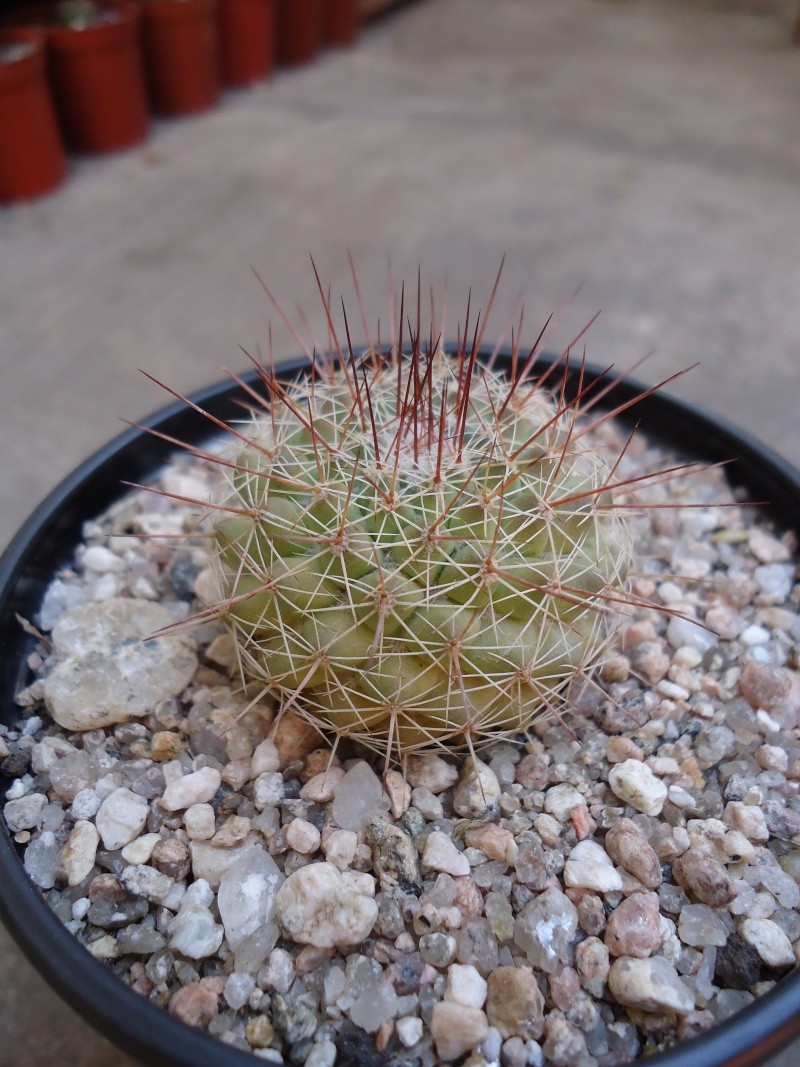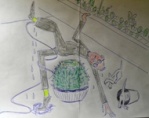 | Mammillaria Society Forum
Discussion Forum about Mammillaria, Coryphantha and Escobaria
|
|
| | 3 mammis to identify: |  |
| | | Author | Message |
|---|
Guest
Guest
 |  Subject: 3 mammis to identify: Subject: 3 mammis to identify:  Thu Dec 24, 2015 5:12 am Thu Dec 24, 2015 5:12 am | |
| Hello there!  I'm lost, which is the identification of these mammillarias? 10 white radial spines, 2 central spines orange / brown:  11 radial spines white and brown, 1 center black spine long and fine:  10-14 radial spines small, 2 central spines one up and one down black and white, little axillary spines:  Thanks!!! |
|   | | maurillio
Number of posts : 2988
Age : 70
Location : Modena - Italia
Registration date : 2009-12-20
 |  Subject: Re: 3 mammis to identify: Subject: Re: 3 mammis to identify:  Fri Dec 25, 2015 3:16 pm Fri Dec 25, 2015 3:16 pm | |
| These do not seem commercial plants but young seedling from a collection..... You can see these option.... # 1 Something near Mammillaria sonorensis # 2 Maybe Mammillaria papasquiarensis https://mammillaria.forumotion.net/t1272-mammillaria-papasquiarensis# 3 Could be Mammillaria formosa like this Mammillaria formosa WTH 819 Photograph ib habitat by Wolter ten Hoeve - Assen  | |
|   | | Guest
Guest
 |  Subject: Re: 3 mammis to identify: Subject: Re: 3 mammis to identify:  Tue Dec 29, 2015 1:12 pm Tue Dec 29, 2015 1:12 pm | |
| The first mammi I thought it might be a mammillaria standleyi or lindsayi. but mammillaria sonorensis best fits your description. The second mammi have no idea, but mammillaria papasquiarensis fits very well. And the third mammi, I thought that was mammillaria chionocephala or pseudocrucigera, but not coincided the description. mammillaria formosa is closer to his suggestion. Maurillio, many many thanks !!!  |
|   | | woltertenhoeve
Number of posts : 343
Registration date : 2009-10-01
 |  Subject: Re: 3 mammis to identify: Subject: Re: 3 mammis to identify:  Sat Jan 02, 2016 8:56 pm Sat Jan 02, 2016 8:56 pm | |
| These mammillarias are still much too small to make an identification attempt. They will have to mature first, i.e. should become much larger and get flowers. But even then, there will remain an uncertainty, as long as the source of the seed from which these mammis were grown, is not exactly known. At first glance, number 3 looks a lot like a M. formosa (which is quite variable), as already suggested by Maurillo.
Wolter ten Hoeve. | |
|   | | maynouf

Number of posts : 13
Age : 57
Location : Barcelona
Registration date : 2015-05-18
 |  Subject: Re: 3 mammis to identify: Subject: Re: 3 mammis to identify:  Mon Jan 04, 2016 10:51 am Mon Jan 04, 2016 10:51 am | |
| Hi,
a couple of naive (or silly) questions on this topic of identification,
- are there easily available references to identify difficult taxa in Mammillaria? I have only Pilbeam's book to go by...
- why are some taxa in Mammillaria easily identified (e.g. M. hernandezi; M. theresae) and other so much more difficult?
Best wishes for the New Year!
Francesc M. | |
|   | | woltertenhoeve
Number of posts : 343
Registration date : 2009-10-01
 |  Subject: Re: 3 mammis to identify: Subject: Re: 3 mammis to identify:  Mon Jan 04, 2016 9:22 pm Mon Jan 04, 2016 9:22 pm | |
| Hi Francesc,
Your question is a very interesting one, and certainly not naive or silly! There are several mammillaria species which are easy to identify, like the ones you mention (theresae and hernandezii), this is especially true for species which have a very limited habitat range (like theresae, hernandezii, and a bunch others). But a few other species, which can be found over a very large area, are also easily identifiable, like M. senilis, M. candida, M. uncinata. Most mammillaria species, however, are more difficult to identify. I have been to Mexico about 15 times and very often I have problems identifying a plant which does not completely fit the picture in the books. In nature, plants are much more variable than in the books and make it often difficult to identify.
When I have such a problem identifying a mammillaria in Mexico, I look up if others have been in the same area and then I look at what name they have attached to that taxon. Then I say, well, that could be true, and I subsequently give my plant the same name. But when I do not have that locality information from others, then it becomes really difficult. A few examples of wide-spread species are M. crinita and M. formosa. You can find them at many locations and at each location they are a bit different from the plants at another location. They almost never fit the perfect textbook picture. Therefore, it is not so strange that investigators have created new species names, whereas others consider these differences too small to warrant all those different names.
Personally, I prefer to have a field location attached to my plants, because then I really know what taxon we are talking about. One example from my own field list, is M. formosa WTH 626 which I had identified as M. sempervivi (Maurillo has put habitat photos of my WTH 626 under M.sempervivi; sorry, Maurillo). On further thought, and on growing seedlings of these plants, I now have classified WTH 626 as M. formosa. There are several more examples from my field list where I have changed the name later on (sometimes after discussing it with others), or where I just have put names like M. aff. crinita, or M. aff. heyderi, so that one can know more or less what the plants with that WTH number shoud look like.
There is certainly a truth in the saying 'the more you know, the less you know'.
Another aspect that should be considered, is that in the greenhouse, somewhat related plants can be hybridized. A few examples: I have given seed of M. duwei WTH 143 and M. swinglei WTH 681 (I had originally identified the latter as M. grahamii/sheldonii) to the German Mammillaria Society. I have now found out, however, that these are actually hybrid seeds, and not the real duwei or swinglei (whereas my original plants certainly were the right stuff, being grown from habitat collected seed). Apparently, hyridization had occurred in my greenhouse. If others, having grown plants from that German Mammillaria seed and having subsequently distributed seeds from those duweis or swingleis, the real duwei or swinglei will be completely lost and after many more cycles of hybridization, we will end up with only one Mammillaria species, M. obscura (or M. confusa), as Wolfgang Plein once said to me.
I hope that I have made a little bit clear how difficult it is to attach a name with certainty to an unknwon plant.
Wolter ten Hoeve. | |
|   | | K.W.

Number of posts : 3242
Age : 66
Location : Deutschland, Köln
Registration date : 2012-09-25
 |  Subject: Re: 3 mammis to identify: Subject: Re: 3 mammis to identify:  Mon Jan 04, 2016 10:21 pm Mon Jan 04, 2016 10:21 pm | |
|
What a good and understandable explanation!
1000 thanks!
Best wishes
K.W.
| |
|   | | maynouf

Number of posts : 13
Age : 57
Location : Barcelona
Registration date : 2015-05-18
 |  Subject: Re: 3 mammis to identify: Subject: Re: 3 mammis to identify:  Tue Jan 05, 2016 9:13 am Tue Jan 05, 2016 9:13 am | |
| Thank you so much Wolter for this reply. I have a decent collection of a few hundred exotic plants and it is true that the more I want to know about them, the less I know. At least for certain difficult genera, such as Mammillaria. For those of us not having the possibility of travelling to the original locations, we'll have to rely on you experts for positive IDs and continue pestering the wise men  All the best, Francesc M. | |
|   | | woltertenhoeve
Number of posts : 343
Registration date : 2009-10-01
 |  Subject: Re: 3 mammis to identify: Subject: Re: 3 mammis to identify:  Wed Jan 06, 2016 6:35 pm Wed Jan 06, 2016 6:35 pm | |
| Thanks, K.W.! Francesc, keep on pestering! WTH 791 is an example of how difficult it is to identify a species found in nature. I found it in 2006 in the state of Guerrero, east of Teloloapan. At first I called it M. xaltianguensis, because it looked quite similar to that plant in Reppenhagen's books. My photos are still labelled with that name. After a discussion with Thomas Linzen (he is a real expert), I changed the name to M. gasterantha, because that species grows in the same general region (perhaps 30 km from my location). Later, when Thomas visited my site of WTH 791, he did not agree anymore with M. gasterantha. We now think that it is closely related to M. virginis. Still, there remains an uncertainty, and therefore M. sp. east of Teloloapan might be the best name for this plant. The attached photos show this plant. I welcome other suggestions for the name of this plant, which belongs to the Polyacanthae. Wolter.   | |
|   | | Guest
Guest
 |  Subject: Re: 3 mammis to identify: Subject: Re: 3 mammis to identify:  Thu Jan 07, 2016 5:18 pm Thu Jan 07, 2016 5:18 pm | |
| |
|   | | Sponsored content
 |  Subject: Re: 3 mammis to identify: Subject: Re: 3 mammis to identify:  | |
| |
|   | | | | 3 mammis to identify: |  |
|
Similar topics |  |
|
| | Permissions in this forum: | You cannot reply to topics in this forum
| |
| |
| |
|
